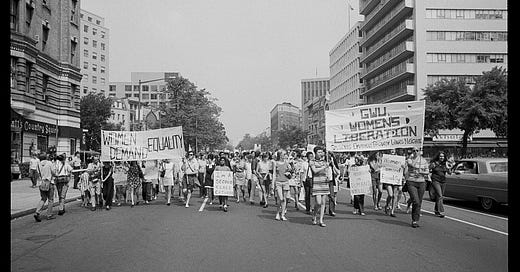Why Women Are Still Second-Class Citizens in the United States
As Women's History Month begins, let's start with the present
Potential new subscribers—free or paid—can access this post, even though it is paywalled. If you know someone who wants to know why women are still fighting the same battles we have for generations, please:

“Celebrating the 50th anniversary of American women's right to vote—and the start of a new crusade for equality —a crowd of more than 10,000 people, mostly women of all ages, occupations and viewpoints, marched down Fifth Avenue to an enthusiastic rally in Bryant Park last night,” Linda Charlton, a rare female New York Times reporter wrote on August 27, 1970.
Charlton, who started her career at Long Island’s Newsday in 1963 and had already won an award, was hired at the Times as a general assignment reporter and night rewrite person, traditionally male jobs at the paper less than two years earlier. But she was still on the “women’s beat.” Even though a trickle of women were finally being hired at major news outlets, female journalists were probably in that march, and another one like it in Washington D.C. that same day. On March 16, 1970, 66 women who had been systematically excluded from writing and editorial jobs at Newsweek had filed a gender discrimination lawsuit, and on July 19, 1972, less than two years after the Women’s Equality March, women at the New York Times did too.
Because of these lawsuits, over half a century later, women have conquered many employment barriers at major media platforms. In a 2019 report that doesn’t mention this activism at all, the New York Times proudly reported that 51% of their employees were women. Although there has only been one female executive editor (so horribly treated by management that she lasted less than three years), 49% of the leadership positions at the paper were occupied by women in 2019.
Women at Newsweek made less progress. In 2010, 40 years after their own lawsuit, two young female reporters at the magazine noted that “the more we talked to our friends and colleagues, the more we heard the same stories of disillusionment, regardless of profession.” In their own workplace, 49% of the business and editorial side was also female, yet the numbers didn’t tell the whole story:
No one would dare say today that "women don't write here," as the Newsweek women were told 40 years ago. But men wrote all but six of Newsweek's 49 cover stories last year—and two of those used the headline "The Thinking Man." In 1970, 25 percent of Newsweek 's editorial masthead was female; today that number is 39 percent.
“Better?” Jessica Bennett (now a contributing editor in the Opinion section of the New York Times) and Jesse Ellison (now a freelance writer living in Midcoast, Maine) asked. “Yes. But it's hardly equality.”
That pretty much sums up how women’s progress in the workplace has stalled. So, now that I have your attention, let’s talk about the reasons.
Keep reading with a 7-day free trial
Subscribe to Political Junkie to keep reading this post and get 7 days of free access to the full post archives.



